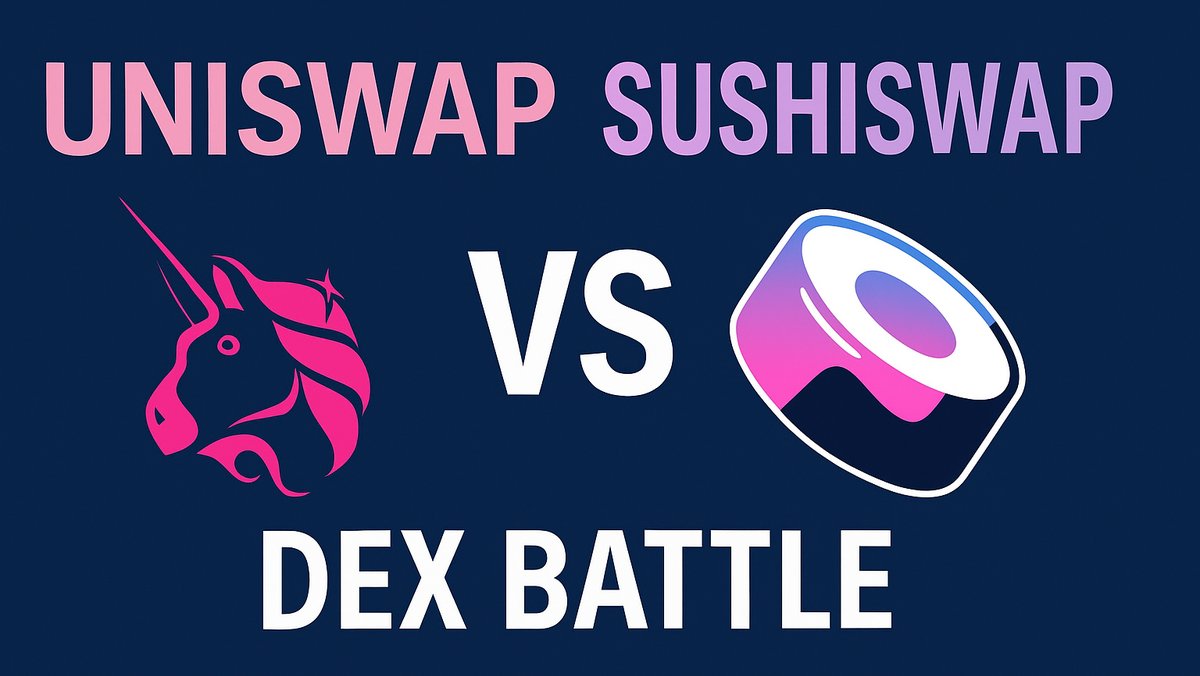Uniswap vs SushiSwap: What Really Differs (AMM, Fees, Incentives, Governance)
TL;DR: Uniswap leads on liquidity depth, volumes, and tooling (v3 concentrated liquidity, UniswapX routing). SushiSwap competes on multi-chain reach and incentive-led liquidity programs. For traders seeking best execution on major pairs, Uniswap usually wins; for yield chasers on emerging chains/pairs, Sushi can still be attractive—provided you understand the risks.
1) AMM Mechanics
- Uniswap: Pioneered x*y=k (v2) and then concentrated liquidity in v3, letting LPs place capital into custom price ranges for higher capital efficiency and lower slippage. More active management required for LPs (rebalancing ranges).
- SushiSwap: Launched as a Uniswap v2 fork with additional token incentives (Onsen). Over time, added route processors, new pool types, and support for concentrated-liquidity style pools on several chains. Historically simpler for passive LPs, but with smaller liquidity on blue-chip pairs vs Uniswap.
2) Trading Fees & LP Rewards
- Uniswap fee tiers: Typical tiers include 0.01%, 0.05%, 0.30%, and 1.00%, chosen per pool based on volatility and market structure. Fees go to LPs; a fee switch can be enabled by governance per pool to redirect a small share (historically off or limited).
- SushiSwap fees: Historically around 0.30% on classic pools (exact splits can vary by pool type and chain). Sushi has used liquidity mining and partner incentives to bolster yields. Reward programs are discretionary and change over time.
Takeaway: Uniswap offers granular fee tiers and deep organic flow; Sushi leans more on incentive-driven APY to attract LPs on smaller pairs and newer networks.
3) Governance & Decentralization
- Uniswap DAO (UNI): Token-weighted governance sets parameters, grants, and deployments. Fee switch optionality exists but has been conservatively explored. Strong delegate ecosystem; brand and IP stewardship by Uniswap Labs (front-end, research, audits).
- Sushi DAO (SUSHI): Community-run with multi-chain focus. Treasury and incentive programs are active levers. Token utility is primarily governance; revenue sharing models have evolved over time, with periods of re-tuning toward sustainability.
Decentralization note: Both protocols are permissionless at the smart contract level. Uniswap’s front-end is run by Uniswap Labs; Sushi’s community/front-end model is more distributed but relies on treasury health and contributor continuity.
4) By the Numbers (illustrative, verify current data before using)
| Metric | Uniswap | SushiSwap | Why it matters |
|---|---|---|---|
| Daily spot volume (typical ranges in active markets) | Often $1–10B across chains | Often $0.1–0.5B | Depth and routing quality correlate with realized slippage |
| TVL (rough, cycle-dependent) | Multi-billion (largest DEX) | Hundreds of millions to low billions | Capital base for low slippage and fee generation |
| Chains supported | Ethereum L1 + major L2s and select L1s | Broad multi-chain footprint incl. alt L1s | Choice of pairs and gas contexts |
| Fee design | Multiple tiers per pool (0.01–1%) | Classic ~0.30% plus variants | Impacts LP APR and trader costs |
| LP incentives | Primarily organic; occasional grants | Incentive-heavy via Onsen/partners | Determines stickiness of liquidity |
| Governance token | UNI (fee switch optionality) | SUSHI (treasury/incentive governance) | Value is governance optionality, not guaranteed yield |
Ranges are indicative of patterns observed through 2024 and will vary by cycle; confirm current figures on reputable dashboards before making decisions.
5) Strategy & Product Differences
- Uniswap: Focus on core AMM quality, research, and infra tooling (e.g., Permit2, routing, and intent-based initiatives such as UniswapX). Strong third-party aggregator inclusion due to depth and reliability.
- Sushi: Community-driven multi-chain expansion, partnerships, and incentives to seed markets that Uniswap may not prioritize. Route Processors and integrations aim to improve execution on long-tail assets.
6) Pros & Cons by User Type
For traders
- Uniswap pros: Best-in-class depth on majors, granular fee tiers, lower slippage on size. Cons: Gas can be higher on mainnet; long-tail tokens may have less farming-driven liquidity than incentive-heavy venues.
- Sushi pros: Broad chain coverage and incentivized pairs can mean tighter spreads for niche tokens on certain chains. Cons: Less depth on blue-chips; execution quality can vary more by chain/pool.
For LPs
- Uniswap pros: Concentrated liquidity lets skilled LPs earn higher fee APR per dollar of capital. Cons: Active management needed; impermanent loss is magnified if ranges are mis-set.
- Sushi pros: Incentives can boost headline APR; simpler pools for passive LPs on some chains. Cons: Incentive decay and mercenary capital risk; APRs drop when programs rotate.
For tokenholders
- UNI: Exposure to governance of the dominant DEX; potential re-rating if compliant fee routing to DAO/treasury becomes durable. Risk: fee switch/legal design and governance conservatism.
- SUSHI: Exposure to DAO-directed incentives/treasury strategy. Risk: sustainability of incentives, treasury management, and competition from larger DEXs.
7) Which should you use?
- Best execution on majors (ETH, stablecoins, top L2 pairs): Typically Uniswap due to depth and routing.
- Yield on niche pairs or newer chains: Sushi can be competitive if incentives are active and liquidity is sticky.
- Cross-chain explorers and aggregators: Use an aggregator to compare in real time; prices move and incentives rotate quickly.
Risk Checklist (both DEXs)
- Smart-contract risk: Only use verified pools; prefer canonical front-ends and audited routers.
- IL and range risk: Concentrated liquidity requires monitoring; passive LPs should size accordingly.
- Incentive dependence: When rewards end, liquidity can migrate—watch program timelines.
- Governance changes: Fee splits, treasury programs, and listing policies can change via DAO votes.
Bottom Line
Uniswap is the default venue for size and majors thanks to liquidity depth and v3 mechanics. SushiSwap remains relevant where incentives and multi-chain reach create pockets of strong execution on long-tail markets. Traders should route competitively each time; LPs should match strategy to their bandwidth: active on Uniswap v3 ranges, program-aware on Sushi incentives.







